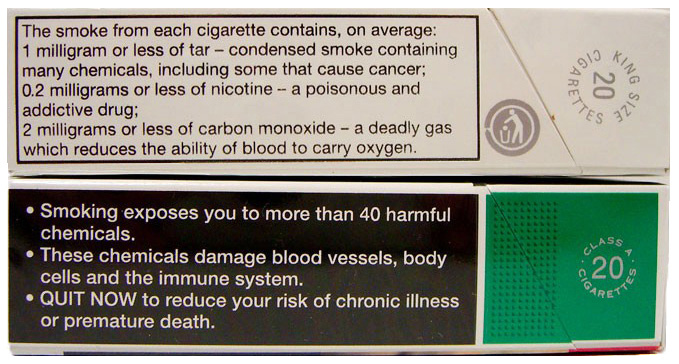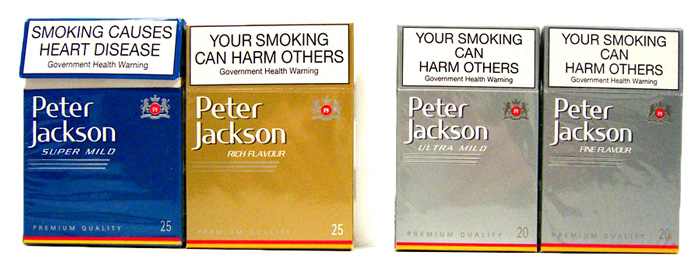Packaging and labelling of tobacco products are used by the tobacco industry for branding and advertising. They have become increasingly important in settings where other forms of branding and advertising are restricted. 1
Tobacco product labelling is used here to refer to text or pictorial information printed on or within tobacco packets, or on the products themselves.
Tobacco product packaging by contrast, describes aspects of the packaging, such as package sizes, shapes, colours, imagery and types of material.
This section describes the past and current labelling on Australian tobacco products.
Packaging is described in Section 5.13.3 and plain packaging is described in detail in InDepth 11A. Trends in cigarette products and packaging are also discussed in detail in Section 10.8, which includes a discussion of branding.
12.9.1 Labelling of tar, nicotine and carbon monoxide yields of Australian cigarettes in the past
It was previously believed that the harms caused by cigarettes could be reduced if the amount of tar and chemicals such as nicotine and carbon monoxide per cigarette were reduced. ‘Yields’ of tar, nicotine and carbon monoxide, as measured by smoking machines, were lower in some types of cigarettes, such as those with filter ventilation (see Sections 12.5.2 and 12.8.2.2 for more details). However, it is now known that these so called ’low-tar’ cigarettes have not reduced the incidence of and mortality from various cancers and heart diseases caused by smoking, as described in Section 12.8.2.4.
This section describes the former use of labelling to indicate tar, nicotine and carbon monoxide levels for Australian cigarettes.
On-pack labelling of tar and nicotine yields commenced in Australia in 1982 and carbon monoxide yields were included from 1989. 2 Tar, nicotine and carbon monoxide figures were printed on the side of packs, as is shown in Figure 12.9.1, using one of a number of nominal yield categories (see Table 12.9.1). Between 1994 and 2006, on-pack tar, nicotine and carbon monoxide ‘average smoke contents’ information was mandated by Commonwealth regulations. Prior to that, there had been a number of voluntary agreements between the Australian Government and the tobacco industry on the labelling of smoke constituents, beginning in 1981. 3 Between 1967 and 1994, the Anti-Cancer Council of Victoria and the Commonwealth Department of Health produced ‘tar tables’ to provide ‘smoke contents’ information to smokers. 2 Publication of ‘tar tables’ ceased after the government sold off its cigarette testing machinery and confined its role to inspection of the industry’s internal yield testing programmes. 2
Figure 12.9.1 Pre-2006 nominal tar, nicotine and carbon monoxide yield labelling (top) and post-2006 qualitative smoke contents labelling (bottom)
The original intent of providing tar yield figures was twofold: firstly, to inform smokers about their likely exposures to hazardous smoke constituents and, secondly, to encourage those smokers who were unwilling or unable to quit to switch to less hazardous brands. 2 Later, it was also believed that ‘low tar’ cigarettes would reduce smokers’ exposure to nicotine, thus facilitating future quit attempts. 2 However, ‘low tar’ cigarettes provided a compelling illusion of reduced intakes, while actually delivering comparable doses of nicotine and other harmful smoke constituents to ‘full flavour’ cigarettes. They may have also diverted smokers from making quit attempts rather than to have facilitated them. 4
When on-pack tar and nicotine yield labelling began in 1982, there were four categories of nominal tar yields or ‘tar bands’: ‘4mg or less’, ‘8mg or less’, ‘12mg or less’ and ‘16mg or less’. 2 The Commonwealth planned to phase out the ‘16mg or less’ category but the tobacco industry successfully negotiated retaining it. Further, in 1989 and 1990, the industry unilaterally added ‘2mg or less’ and ‘1mg or less’ tar bands. These were subsequently included in the Commonwealth regulations. Later still, the industry added a ‘6mg or less’ tar band for some brand families.
Having the market segmented into ‘tar bands’ enabled the Australian tobacco industry to create a larger variety of ‘light’ and ‘mild’ varieties than has existed in any other country. 5 In other countries, major brand families generally only had ‘regular’, ‘light’ and ‘ultra-light’ varieties. However, in Australia, nearly all major brand families were extended to fill each of the six tar bands, with combinations of ‘mild’ or ‘light’ descriptors and different pack colours used to differentiate the varieties. 5 In the following years, extra nominal tar yield categories, including ‘6mg or less’ and ‘10mg or less’ were used for some brand families, presumably for the purpose of creating further product differentiation within the most popular ‘middle tar’ yield range.
In 2005 the Australian Competition and Consumer Commission (ACCC) determined that ‘light’ and ‘mild’ labelling of cigarette varieties was misleading conduct and obtained undertakings from two of the three manufacturers (Philip Morris and British American Tobacco) to remove such labelling. The third manufacturer, Imperial Tobacco, was eventually persuaded to do so under threat of litigation. Also, in March 2006, tar, nicotine and carbon monoxide figures were replaced with qualitative information about harmful smoke constituents under new health warnings (see Figure 12.9.2). However, colour-coding of packs and ‘smooth’ and ‘fine’ descriptors continue to be used to identify brand family members with differing taste and harshness characteristics. 6 Further, many smokers may retain some memory of the nominal tar yields of their chosen brands, as for nearly a year after the ACCC’s determination, the new ‘smooth’ and ‘fine’ descriptors appeared together with nominal tar, nicotine and carbon monoxide figures.
Figure 12.9.2 Two Peter Jackson brand varieties before and after the ban on 'light' and 'mild' descriptors in 2005
12.9.2 Current labelling requirements for tobacco products in Australia
Labelling of cigarettes and other tobacco products sold in Australia is subject to considerable regulation. These rules also apply to images of these products that appear on Australian websites selling them. The regulations in Australia include:
- Mandatory graphic and text health warnings, as discussed in InDepth 12A
- Limits to the type of information that can be printed on tobacco product packages
Since 2012 under plain packaging regulations, the information on cigarette packets in Australia has been strictly prescribed allowing only the brand name, product name, contact details of the company, country in which the product was made, health warnings, fire safety compliance statement, the number of cigarettes in the pack and a bar code. 7 , 8 The font and size of the text is also stipulated. These appear on a background of plain packaging, with the same drab dark brown colour used for all products. Cigarette cartons must be similarly labelled. 8 On Australian websites, cigarettes are only advertised using an image of a health warning, plus the product name, company and weight of the product. Manufacturers may not use the terms ‘light’ or ‘mild’ (see below) however they are not otherwise restricted in their choice of brand names or the terms used to describe brand variants, and many of these include reference to the filter type or to novelty features such as menthol crush-balls—see Supplementary Table 10.7.
Pipe and roll-your-own tobacco are usually sold in Australia in resealable pouches or round tins. 8 Labelling of these products is restricted to plain packaging, health warnings, product and company names, contact details of the company, country where it was made, weight of the product and bar code. 7 They also have a description of the tobacco, such as ‘rolling tobacco’ or ‘pipe tobacco’. Names of loose tobacco products names currently for sale in Australia include terms such as ‘organic’ and ‘no additives’, which may falsely imply that these products are less harmful than regular products, see Section 10.8.5. On sales websites, these products are also described using the packaging description, such as ‘resealable pouch’ or ‘tin’.
Cigars in other countries are labelled with a wide range of colours and packaging types, particularly those that promote the premium or elitist branding of the product. They usually have a paper band around the cigar for branding and identification. Cigars are sold in Australia in tins or boxes, or as single products in tubes. 8 These containers are regulated similarly to other tobacco products, being restricted to plain packaging, health warnings and basic descriptions of the product and company. 7 , 8 Paper bands around cigars sold in Australia are also subject to plain packaging, showing only the product name and company on the one background colour. 8 On Australian websites, cigars are labelled with more detail than other tobacco products. Descriptors may include the type of cigar (e.g. premium, large, little, cigarillo, dry), the gauge (diameter) and size descriptors such as ‘slim’ or length measurements. They also include the type of tobacco in the binder, wrapper and filler, and the strength, e.g. ‘full’. Names of cigars may include descriptions of flavours such as cherry, vanilla and bourbon. Little cigars may also include descriptions of flavoured filters such as ‘rum-filtered’. Some products have implications of quality in the name, such as ‘#1 CIGAR OF THE YEAR 2019’.
Waterpipe tobacco, kreteks and bidis sold in Australia are also subject to plain packaging requirements. 7 On websites and on the packets, they are limited to health warnings plus brief descriptions of the product and company. The names of waterpipe tobacco usually include descriptions of flavour, such as ‘mango papaya twist’ or ‘tropical passion’. Kreteks (tobacco and clove cigarettes originating in Indonesia) sold in Australia often use the word ‘clove’ in their description. Kreteks may be labelled as ‘imported cigarettes’ on Australian websites, though all factory-made cigarettes sold in Australia are imported. Bidis sold in Australia are subject to the same labelling regulation and may include a single black thread around the circumference of the bidi. 7
Relevant news and research
A comprehensive compilation of news items and research published on this topic (Last updated April 2025)
Read more on this topic
References
1. World Health Organization. Tobacco packaging and labelling. 2014. Last update: Viewed Available from: http://apps.who.int/iris/bitstream/handle/10665/204198/Fact_Sheet_TFI_2014_EN_15309.pdf;jsessionid=DF29D028C0252291BB841675606689F6?sequence=1.
2. King W, Carter SM, Borland R, Chapman S, and Gray N. The Australian tar derby: The origins and fate of a low tar harm reduction programme. Tobacco Control, 2003; 12 Suppl 3(suppl. 3):iii61-70. Available from: https://www.ncbi.nlm.nih.gov/pubmed/14645950
3. Winstanley M, Woodward S, and Walker N, Tobacco in Australia: Facts and issues, 1995. 2nd edn. Carlton South: Victorian Smoking and Health Program; 1995. Available from: http://www.quit.org.au/quit/FandI/welcome.htm.
4. Tindle HA, Shiffman S, Hartman AM, and Bost JE. Switching to "lighter" cigarettes and quitting smoking. Tobacco Control, 2009; 18(6):485-90. Available from: https://www.ncbi.nlm.nih.gov/pubmed/19892697
5. King B and Borland R. The 'low tar' strategy and the changing construction of Australian cigarettes. Nicotine & Tobacco Research, 2004; 6(1):85–94. Available from: https://pubmed.ncbi.nlm.nih.gov/14982692
6. King B and Borland R. What was "light" and "mild" is now "smooth" and "fine": New labelling of Australian cigarettes. Tobacco Control, 2005; 14(3):214-5. Available from: https://www.ncbi.nlm.nih.gov/pubmed/15923475
7. Australian Government. Tobacco plain packaging regulations 2011. Australia Government Federal Register of Legislation, 2011. Last update: Viewed Available from: https://www.legislation.gov.au/Details/F2018C00935.
8. Australian Government Department of Health. Tobacco plain packaging: Your guide. 2014. Last update: Viewed Available from: https://www.health.gov.au/resources/publications/tobacco-plain-packaging-your-guide?language=en